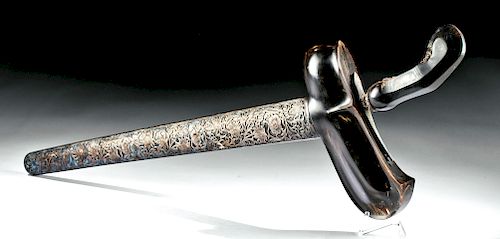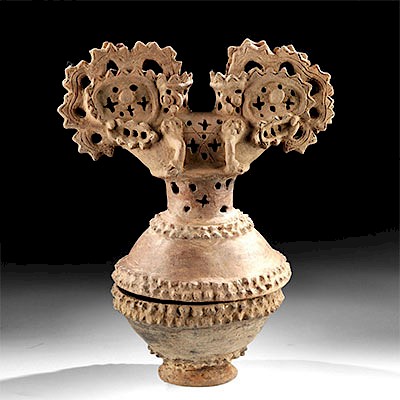Early 20th C. Indonesian Kris w/ Horn & Sapphire Handle
Lot 61
About Seller
Artemis Gallery
686 S Taylor Ave, Ste 106
Louisville, CO 80027
United States
Selling antiquities, ancient and ethnographic art online since 1993, Artemis Gallery specializes in Classical Antiquities (Egyptian, Greek, Roman, Near Eastern), Asian, Pre-Columbian, African / Tribal / Oceanographic art. Our extensive inventory includes pottery, stone, metal, wood, glass and textil...Read more
Categories
Estimate:
$800 - $1,200
Absentee vs Live bid
Two ways to bid:
- Leave a max absentee bid and the platform will bid on your behalf up to your maximum bid during the live auction.
- Bid live during the auction and your bids will be submitted real-time to the auctioneer.
Bid Increments
| Price | Bid Increment |
|---|---|
| $0 | $25 |
| $300 | $50 |
| $1,000 | $100 |
| $2,000 | $250 |
| $5,000 | $500 |
| $10,000 | $1,000 |
| $20,000 | $2,500 |
| $50,000 | $5,000 |
| $100,000 | $10,000 |
| $200,000 | $20,000 |
About Auction
By Artemis Gallery
Aug 22, 2019
Set Reminder
2019-08-22 10:00:00
2019-08-22 10:00:00
America/New_York
Bidsquare
Bidsquare : Fine Ancient | Asian | Ethnographic Art
https://www.bidsquare.com/auctions/artemis-gallery/fine-ancient-asian-ethnographic-art-4348
Featuring classical antiquities, ancient and ethnographic art from cultures encompassing the globe, plus fine art. Egyptian, Greek, Roman, Etruscan, Near Eastern, Asian, Pre-Columbian, Native American, African / Tribal, Oceanic, Spanish Colonial, Russian, Fine Art, so much more! Artemis Gallery info@artemisgallery.com
Featuring classical antiquities, ancient and ethnographic art from cultures encompassing the globe, plus fine art. Egyptian, Greek, Roman, Etruscan, Near Eastern, Asian, Pre-Columbian, Native American, African / Tribal, Oceanic, Spanish Colonial, Russian, Fine Art, so much more! Artemis Gallery info@artemisgallery.com
- Lot Description
Southeast Asia, Indonesia, ca. early 20th century CE. A dramatic example of a kris (keris) with a gorgeous cow horn handle. An artist has painstakingly carved the curved interior of the horn with mask-like faces at the top and bottom. Smooth, dark horn also forms the characteristically large guard. The blade is straight and narrow, aside from the characteristic flaring portion immediately below the guard. A repousse tin covering with a complex floral motif covers the wooden sheath. Size: 6.5" W x 20.5" H (16.5 cm x 52.1 cm)
The kris is both a weapon and a spiritual object. The oldest known are from the 10th century CE; they are thought to have originated on the island of Java. The bladesmith, called an empu, formed the blade from layers of different iron ores and meteorite nickel. In high quality ones, the metal is folded dozens or even hundreds of times. Kris were worn every day and in special ceremonies; both men and women wear them. They were passed down through families. They were used for display, as talismans with magical powers, and weapons, and as heirlooms, as accessories for ceremonial dress, and indicators of social status. Kris blades are narrow, with wide, symmetrical bases. The aesthetic value has three elements: dhapur, the shape and design of the blade, with 40 variants; pamor, the pattern of metal alloy decoration on the blade, with 120 variants; and tangguh, the age and origin of kris. In 2005, the kris became a UNESCO Masterpiece of the Oral and Intangible Heritage of Humanity.
Provenance: private Rochester, Michigan, USA collection
All items legal to buy/sell under U.S. Statute covering cultural patrimony Code 2600, CHAPTER 14, and are guaranteed to be as described or your money back.
A Certificate of Authenticity will accompany all winning bids.
We ship worldwide and handle all shipping in-house for your convenience.
#138010Excellent aged patina over wooden, metal, and horn surfaces. Blade is in excellent condition. Slight encrustation in lower profile areas of decorative carvings.Condition
- Shipping Info
-
All shipping is handled in-house for your convenience. Your invoice from Artemis Gallery will include shipping calculation instructions. If in doubt, please inquire BEFORE bidding for estimated shipping costs for individual items.
-
- Buyer's Premium



 EUR
EUR CAD
CAD AUD
AUD GBP
GBP MXN
MXN HKD
HKD CNY
CNY MYR
MYR SEK
SEK SGD
SGD CHF
CHF THB
THB















